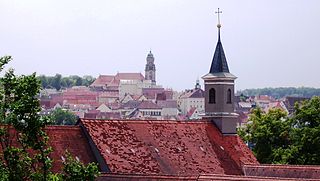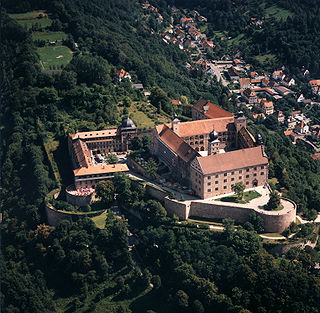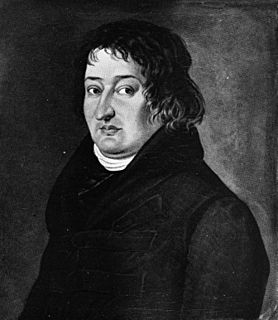

The New Castle (Neues Schloss) is a nineteenth century palace in Hechingen in Germany. It served as the city residence for princes of the House of Hohenzollern-Hechingen.


The New Castle (Neues Schloss) is a nineteenth century palace in Hechingen in Germany. It served as the city residence for princes of the House of Hohenzollern-Hechingen.
The first building on the site was a Renaissance-style residence built by Eitel Frederick IV, Count of Hohenzollern in the late 16th century. Apart from a few minor remnants, it was demolished by Friedrich Hermann Otto at the start of the 19th century to make way for the three-wing present structure, built between 1818 and 1819, designed by Rudolf Burnitz and funded by French reparations from the Congress of Vienna. Burnitz was a pupil of Friedrich Weinbrenner, a leading neo-classical architect in the Grand Duchy of Baden. The castle remained unfinished, since the principality was in debt and the funds for its construction ran out.
| Wikimedia Commons has media related to Neues Schloss Hechingen . |

The House of Hohenzollern is a German former royal dynasty whose members were variously princes, electors, kings and emperors of Hohenzollern, Brandenburg, Prussia, the German Empire, and Romania. The family arose in the area around the town of Hechingen in Swabia during the 11th century and took their name from Hohenzollern Castle. The first ancestors of the Hohenzollerns were mentioned in 1061.

Hohenzollern-Sigmaringen was a principality in southwestern Germany. Its rulers belonged to the senior Swabian branch of the House of Hohenzollern. The Swabian Hohenzollerns were elevated to princes in 1623. The small sovereign state with the capital city of Sigmaringen was annexed to the Kingdom of Prussia in 1850 following the abdication of its sovereign in the wake of the revolutions of 1848, then became part of the newly created Province of Hohenzollern.

Sigmaringen is a town in southern Germany, in the state of Baden-Württemberg. Situated on the upper Danube, it is the capital of the Sigmaringen district.

Hechingen is a town in central Baden-Württemberg, Germany. It is situated about 60 kilometres (37 mi) south of the state capital of Stuttgart and 90 kilometres (56 mi) north of Lake Constance and the Swiss border.

Hohenzollern-Hechingen was a small principality in southwestern Germany. Its rulers belonged to the Swabian branch of the Hohenzollern dynasty.

Plassenburg is a castle in the city of Kulmbach in Bavaria. It is one of the most impressive castles in Germany and a symbol of the city. It was first mentioned in 1135. The Plassenberg family were ministerial of the counts of Andechs and used as their seat the Plassenburg. The House of Guttenberg, a prominent Franconian noble family, traces its origins back to 1149 with a Gundeloh v. Blassenberg (Plassenberg). The name Guttenberg is derived from Guttenberg and was adopted by a Heinrich von Blassenberg around 1310. From 1340, the Hohenzollerns governed from Plassenburg castle their territories in Franconia till 1604. The Plassenburg was fortress and residence for the Hohenzollerns.

Hohenzollern Castle is the ancestral seat of the imperial House of Hohenzollern. The third of three hilltop castles built on the site, it is located atop Mount Hohenzollern, above and south of Hechingen, on the edge of the Swabian Jura of central Baden-Württemberg, Germany.

Sigmaringen Castle was the princely castle and seat of government for the Princes of Hohenzollern-Sigmaringen. Situated in the Swabian Alb region of Baden-Württemberg, Germany, this castle dominates the skyline of the town of Sigmaringen. The castle was rebuilt following a fire in 1893, and only the towers of the earlier medieval fortress remain. Schloss Sigmaringen was a family estate of the Swabian Hohenzollern family, a cadet branch of the Hohenzollern family, from which the German Emperors and kings of Prussia came. During the closing months of World War II, Schloss Sigmaringen was briefly the seat of the Vichy French Government after France was liberated by the Allies. The castle and museums may be visited throughout the year, but only on guided tours. It is still owned by the Hohenzollern-Sigmaringen family, although they no longer reside there.
Hohe Karlsschule was the strict military academy founded by Karl Eugen, Duke of Württemberg in Stuttgart, Germany. It was first founded in 1770 as a military orphanage, but then converted into a military academy in 1773 for the duke.

Friedrich Weinbrenner was a German architect and city planner admired for his mastery of classical style.

Josef Friedrich Wilhelm, was prince of Hohenzollern-Hechingen from 1750 until his death.

Bettembourg Castle located in the centre of Bettembourg in the south of Luxembourg has a history starting in 1733 when it was built as the residence of a farming family. Today it houses the offices and services of the local commune.
Johann Georg of Hohenzollern-Hechingen was the first Prince of Hohenzollern-Hechingen.

Count Eitel Friedrich IV of Hohenzollern was the founder and first Count of the line Hohenzollern-Hechingen as Eitel Friedrich I.

Friedrich Ludwig of Hohenzollern-Hechingen was prince of Hohenzollern-Hechingen.

Prince Johann of Hohenzollern-Sigmaringen, was the ruling Count of Hohenzollern-Sigmaringen from 1606 to 1623. He was elevated to the rank of prince in 1623 and so was Prince of Hohenzollern-Sigmaringen from 1623 until his death.

Jobst Nikolaus I, Count of Hohenzollern was a German nobleman from the Swabian branch of the House of Hohenzollern. He was the ruling Count of Hohenzollern from shortly after his birth until his death.

Friedrich XII, Count of Hohenzollern, nickname Friedrich the Oettinger was a German nobleman. He was a member of the Swabian branch of the House of Hohenzollern. His father was Friedrich XI, Count of Hohenzollern; his younger brother and rival was Eitel Friedrich I, Count of Hohenzollern.

The castles of Dahn, near the little town of Dahn in the German state of Rhineland-Palatinate, consist of three rock castles:

Rudolf Burnitz was a German neo classical and early historicist architect. Burnitz was born in Ludwigsburg.